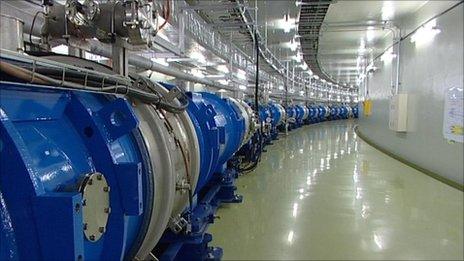Neutrino experiment to get UK 'heart'
- Published

Magnets control the proton beam before it hits the carbon target
It's taken a decade of work and cost a million pounds but a massive particle detector designed and built in the UK is being installed at the heart of a groundbreaking Japanese experiment.
The detectors will be looking for neutrino particles in an experiment that aims to answer some of the big questions in physics.
But it won't be easy.
Dr Gary Barker from the University of Warwick helped design and build the detectors. According to him, experiments to look for neutrinos "need to be really big or to have plenty of neutrinos. Or preferably both".
The experiment, called T2K and based at Tokai in Japan, certainly fulfills Dr Barker's requirements. It is a massive achievement made possible in total by scientists from eight other UK institutions and 11 other countries.
Learning more about neutrinos is key to some pretty fundamental physics questions. Not least, why are we here? Or at least why is the universe is made of matter, allowing us to be here?
Matter imbalance
During the Big Bang equal amounts of matter and antimatter should have been created and then annihilated. But since our Universe exists though there must have been an imbalance between the two. More matter than anti-matter.
It is thought the neutrino could haveplayed a role in this. Unfortunately for physicists, neutrinos are very hard to detect and measure, which is where this new experiment and the new detector comes in.

The T2K experiment and its detectors are located in a deep pit
At the JParc laboratory in Tokai, on the east coast of Japan, protons will be accelerated round a ring 1.6km in circumference.
The entire beam will then be smashed into a carbon rod and create particles that will go on to form that all important beam of neutrinos.
The beam will then pass through the detector built by the universities of Warwick and Liverpool. This detector is "absolutely indispensable to the experiment" according to Professor Takashi Kobayashi, spokesman for the Japanese half of the team.
The beam will then travel nearly 300km to another laboratory called Super Kamiokande on the west coast of Japan. It will actually pass through the Earth before hitting the Super Kamiokande detector deep underground.
The aim of the experiment is to see what happens to the neutrinos as they travel between the two laboratories. Neutrinos have three different flavours and they flip between them. It's this flipping or oscillation that the experiment aims to study.
Eventually the researchers will learn more about the neutrino and that in turn will tell them about the nature of the next neutrino experiment.
They will need to build to finally understand this most elusive of particles. And then we'll finally learn just what went on in the early Universe that lead to that left over matter and eventually to you and me.